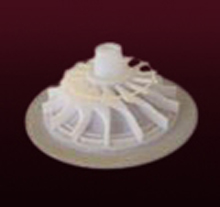

 Product Design
Product Design

 Rapid Prototyping
Rapid Prototyping
 CNC Prototyping
CNC Prototyping Rapid Prototyping
Rapid Prototyping Stereolithography Apparatus (SLA)
Stereolithography Apparatus (SLA) Selective Laser Sintering (SLS)
Selective Laser Sintering (SLS) Fused Deposition Modeling (FDM)
Fused Deposition Modeling (FDM) Laminated Object Manufacturing (LOM)
Laminated Object Manufacturing (LOM)
 Custom Molds - Plastic Molds
Custom Molds - Plastic Molds

 Plastic Molding
Plastic Molding

 Production Tooling
Production Tooling

Rapid Prototyping
 Introduction:
Introduction:
Rapid prototyping is usually referred to as additive fabrication, because the process involves building up the object by the addition of successive layers. CAD drawing information is downloaded to the rapid prototyping machine, which uses that data to incrementally create the object.
Rapid Prototyping involves transforming virtual designs from CAD or 3D modeling software into virtual cross-sections. The rapid prototyping or 3D printing machine reads data from a CAD drawing and lays down successive layers of plastic, constructing the 3D-prototype from a series of cross-sections. These layers, which correspond to the virtual cross-section from the CAD model, are glued together or fused ( using a laser or UV light) automatically to create the final shape.
Highlights:
- One of the most widely used methods.
- Simple process.
- Expeditiously completed.
Applications:
- Concept Modeling
- Finite Element Analysis
- Presentation Models
 We are constantly looking for new products in order to grow our business and Invention Home has enabled us to streamline that process much more quickly.
We are constantly looking for new products in order to grow our business and Invention Home has enabled us to streamline that process much more quickly. Marsha Dunmyre
CA, U.S.A
Cool Prototyping Copyright 2008-2009 © All Rights Reserved. Rapid Prototyping

